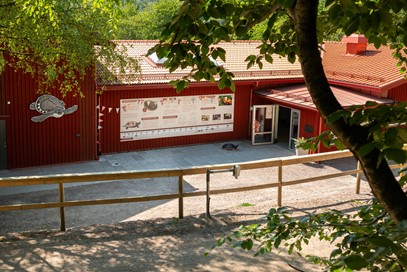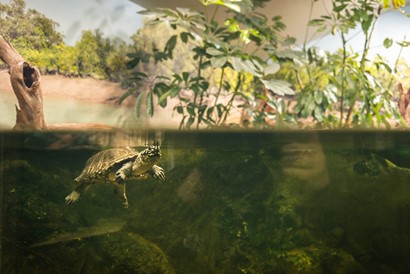The Turtle Ark
One of the world's most endangered groups of animals, which have existed on earth for over 200 million years, are turtles. The International Union for Conservation of Nature (IUCN)'s Tortoise and Freshwater Turtle Specialist Group reports that over 60% of the world's turtle species are threatened with extinction. It is human progress that has caused the turtles to decline. Forests and streams are vacuumed in search of turtles to sell as pets or as delicacies. Their habitats disappear when forests are cut down, wetlands ditched and rivers dammed. The situation is most acute in Asia, where all of the nearly 100 turtle species are endangered. Of species that were once numerous in lakes and river systems, today only a few hundred individuals exist, sometimes as few as a few dozen. To preserve some of the world's most endangered turtles, Nordens Ark started the project On the edge of extinction - an Ark for the world's turtles. Through the project, Nordens Ark is building a unique breeding center and creating insurance populations where some of the world's most vulnerable species can find refuge and reproduce for future releases. The project also aims to create conditions for long-term survival in the species' original environments by building cooperation with local organizations and authorities.

The entrance to the Turtle Ark.
What does Nordens Ark do?
Nordens Ark's breeding center An Ark for the world's turtles is home to several of the world's most endangered turtle species with a special focus on large and more space-consuming species from Asia. The situation for many of these species is acute. Improving the situation in the wild will take a long time and for some species time is running out. The only solution to ensure their survival is to keep insurance populations in breeding facilities. Insurance populations are managed through strict breeding programs in collaboration between different actors in order to maintain as much genetic variation as possible. The ultimate goal is to be able to re-implant species in protected areas within their former distribution areas in the future. This presupposes that the threats have been handled and that adequate protective measures are in place. The project will, in collaboration with local organizations and authorities, initiate and support nature conservation measures to preserve / re-establish wild populations. Without a insurance population, intensive work with authorities and local people regarding nature conservation measures and information, the species will never be able to be returned to their natural environment.
Our work focuses on the following strategic areas:
- To drive and participate in insurance populations in order to be able to return species to the wild in the future
- To preserve species within their natural range
- To inform and engage children and adults in the work of conserving turtles

Spotted pond turtle at the Turtle Ark.
News from the project - March 2024
During the winter and spring, two exciting breeding trials take place in the Turtle Ark. For the Vietnamese pond turtle, we have received a breeding recommendation for two of our wild-born individuals, which with their unique genes have great conservation value for the survival of the species. Both individuals were captured in Vietnam about 35 years ago, then sold as pets before finally being handed over to the conservation project at Nordens Ark. Mating between these two important individuals has already been observed and we are keeping our fingers crossed for eggs soon.
The Vietnamese pond turtle is also one of the species of priority in the conservation campaign Vietnamazing which aims to protect the incredibly rich biodiversity that is threatened with disappearance.
In addition, we will also for the first time start a breeding trial for southern river terrapin. There are not that many keepers of the species in the world and there is only one recorded successful mating in Europe, namely at a zoo in Prague. Both the female and the male are now in the secluded breeding center in the Turtle Ark before breeding. The preparations for the breeding trial involve changing both the water temperature and water height in the pools according to a certain schedule. With this, we hope to make the turtles believe that the monsoon rains have started and thus the mating season.









